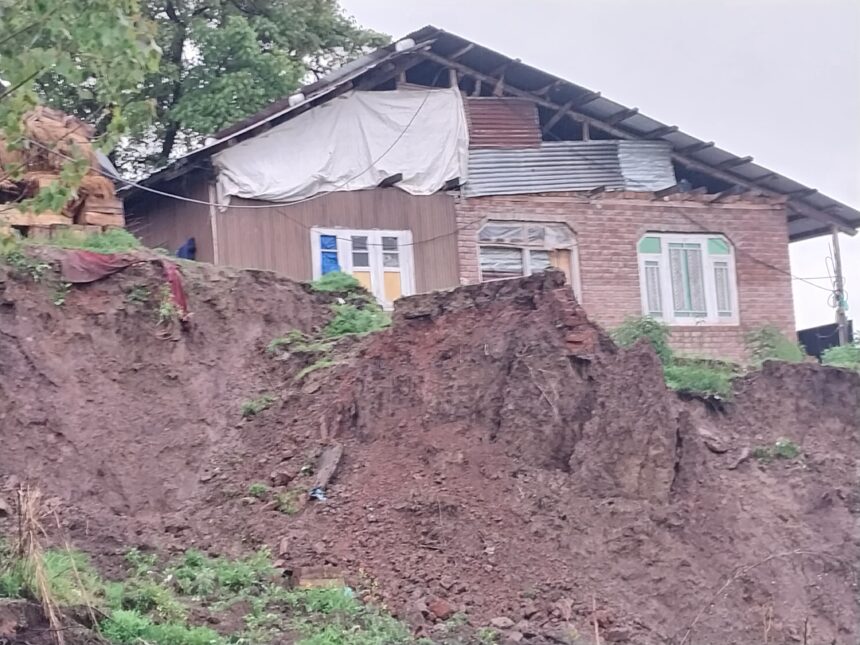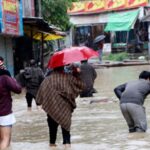Srinagar, Apr 29: In the aftermath of significant damage to over 50 houses, electricity towers, a receiving station, and a vital link road in Pernote village in Ramban due to land sinking, experts are attributing the issue to water seepage and human activities, emphasizing the need for robust urban planning to mitigate future disasters.
Experts, including noted geologists Prof. Abdur Hafiz from AMU and Prof. S.K. Pandita from the University of Jammu, highlight water saturation as a significant cause, where excessive rainfall or groundwater infiltration saturates the soil, reducing its stability and leading to slope instability. They also underscore the role of erosion and human activities such as deforestation and improper land use practices in exacerbating the situation.
“Erosion plays a crucial role, as the gradual removal of soil and rock layers by natural processes like runoff or snowmelt weakens the slope over time, making it susceptible to sinking,” he said.
Prof. Hafiz said that human activities also contribute to land sinking in high slopes. He said deforestation, construction of projects and improper land use practices can disturb the natural equilibrium of slope, increasing its vulnerability to sinking.
“By removing vegetation, altering drainage patterns or introducing heavy loads, such activities can further destabilize already fragile slopes. Understanding these interconnected factors is essential for effective land management in high slope areas,” Prof. Hafiz said.
Experts say in the higher reaches of Jammu and Kashmir, water seepage is the reason behind the land subsidence and it is common in sloppy areas.
Geologist and Researcher, Prof. S.K. Pandita from Department of Geology, University of Jammu said the rain water must be getting accumulated somewhere and when that water gets accumulated beyond the land capacity, it increases hydrostatic pressure after which land subsidence can take place.
“Land subsidence refers to the vertical sinking of land and consists of earth’s surface moving downwards vertically and involves little or no movement horizontally. The reason behind subsidence can be both natural causes and human actions,” Prof. Pandita said.
He suggested that locals should be trained so that they are prepared for such disaster situations and people should be informed of avoiding work which can be fatal in future.
Dr.Irfan Rashid, Senior Assistant Professor at Department of Geo-informatics, University of Kashmir said when roads and highways are constructed on steep slopes; population and infrastructure are prone to such disasters.
“The soil loses its cohesive strength due to cutting of steep slopes increasing the probability of landslides and associated subsidence. These areas are also seismically active that could trigger mass wasting,” he said.
Dr.Irfan said mostly such cases have been reported in Chenab belt due to extensive cutting of steep slopes and damming of waters that trigger landslides and land subsidence, washing away roads at various places.
“To overcome these disasters, we should have robust urban land use plans. I don’t think that there is any scientifically informed land use plan or land suitability assessment over these prone landscapes. Such assessments would inform the policy makers to plan disaster resilient infrastructure,” he said.
Dr.Irfan said that since such plans are not visible on ground, mass wasting hazards like land subsidence and mass wasting would be frequent.
Former Head of Department of Geology, University of Jammu, Prof. G.M. Bhat also stated that there can be multiple reasons behind the Ramban land sinking.
“Land subsidence is a sudden sinking of land. Its primary causes are the removal of underground water, compaction, and drainage of organic soils, underground mining, and thawing permafrost. The primary cause of subsurface soil loss after heavy rains,” he said.
Prof. Bhat said the occurrence of land subsidence is seldom as obvious as it is in the case of catastrophic sinkholes or mine collapses. “Where groundwater depletion is involved, subsidence is typically gradual and widespread,” he said.
In Pernote village, there was a big scare when more than 50 houses collapsed suddenly because of land sinking.
Waseem Ahmad, a local said that there is fear among people and maximum houses in the village have developed cracks. Administration has come forward for our rescue and we are currently living in another place,” he said.
Nisar Ahmad Khatana, another resident, said that the important road from Pernote to Ramban is still blocked from the district headquarters. However, to address this, the administration has arranged an alternate route through Sumber-Digdoal to link Gool sub-division with Raman.
Local authorities, led by Deputy Commissioner Baseer-ul-HaqChoudhary, have mobilized resources to assist affected families, including arranging alternative routes and providing food, shelter, and medical aid. Efforts are underway to restore essential services like road connectivity and electricity, with geology experts summoned to investigate the cause behind the land sinking.
“The land is still sinking and efforts are on to restore essential services like road and electricity which is our first priority. We will provide tents, other logistics and organize medical camps for victims,” DC Ramban said.
In February last year, at least 16 houses were damaged and road connectivity between Gool and Ramban was snapped due to land sinking at DuksarDalwa village in Sangaldan area.








